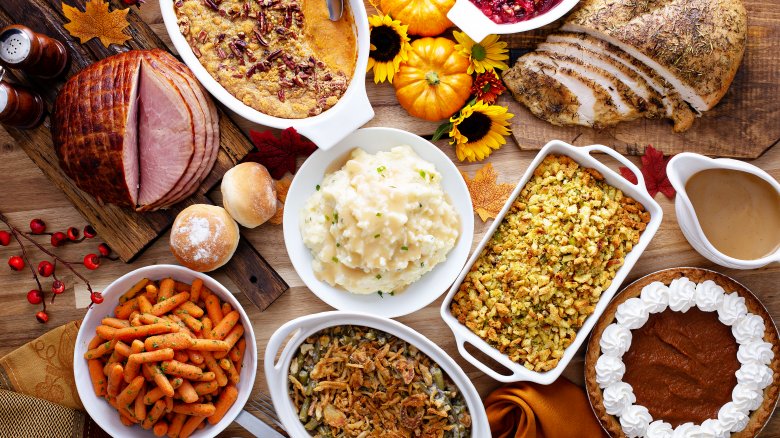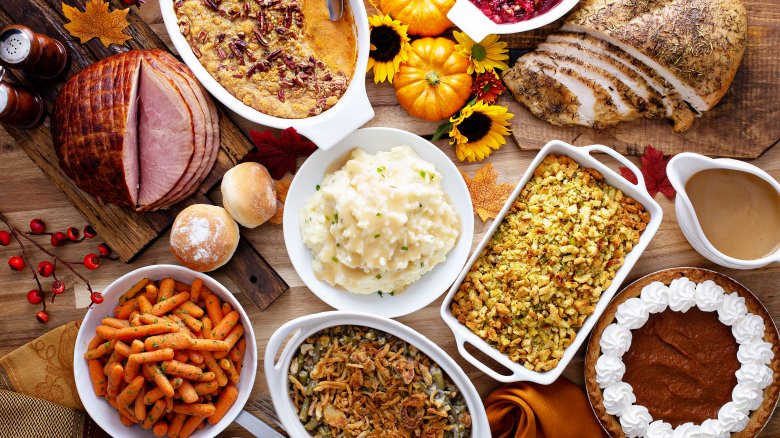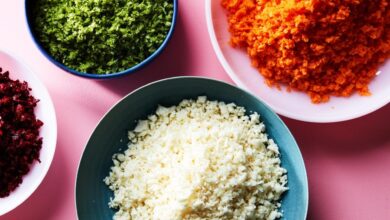
Build a Healthier Holiday Plate
Build healthier holiday plate – Build a Healthier Holiday Plate: The holidays are a time for joy, celebration, and, of course, delicious food. But with all the tempting treats and rich dishes, it can be easy to overindulge and compromise our health. This holiday season, let’s take a mindful approach to our eating habits and create a festive plate that satisfies our cravings without sacrificing our well-being.
We’ll explore practical tips and strategies to create a balanced holiday plate that includes a variety of nutrient-rich foods, portion control techniques, and smart substitutions for classic holiday dishes. We’ll also discuss the importance of staying active during the holiday season to balance out the festive indulgences.
So, let’s embark on this journey together and learn how to build a healthier holiday plate that allows us to enjoy the festivities while prioritizing our health.
Understanding the Holiday Plate
The holiday season is a time for celebration, family, and delicious food. However, it’s also a time when many of us overindulge, leading to unhealthy eating habits and potential health risks. Understanding the importance of a balanced holiday plate can help you enjoy the festive season without compromising your health.
The Importance of a Balanced Holiday Plate
A balanced holiday plate is crucial for maintaining overall health and well-being during the festive season. It ensures that you consume a variety of nutrients, including essential vitamins, minerals, and fiber, which are vital for supporting your immune system, energy levels, and digestive health.
By incorporating a balance of protein, carbohydrates, healthy fats, and fiber, you can feel satisfied and energized throughout the holidays.
Potential Health Risks Associated with Unhealthy Holiday Eating Habits
Unhealthy holiday eating habits can lead to several health risks, including:
- Weight Gain:Overconsumption of calorie-rich foods, especially those high in sugar and unhealthy fats, can contribute to weight gain.
- Increased Risk of Chronic Diseases:Unhealthy holiday eating habits can increase the risk of developing chronic diseases such as type 2 diabetes, heart disease, and certain types of cancer.
- Digestive Issues:Overeating can lead to indigestion, bloating, and constipation.
- Mood Swings:Sugar highs and crashes associated with excessive sugar intake can contribute to mood swings and irritability.
Tips for Creating a Visually Appealing Holiday Plate
Creating a visually appealing holiday plate can encourage healthy choices and make your meals more enjoyable. Here are some tips:
- Use a Variety of Colors:A plate filled with different colors is more visually appealing and suggests a balanced meal.
- Incorporate Seasonal Produce:Incorporate fresh, seasonal fruits and vegetables for a vibrant and healthy touch.
- Think Beyond the Main Course:Don’t forget to include side dishes like roasted vegetables, salads, and whole-grain options.
- Portion Control:Use smaller plates to control portion sizes and prevent overeating.
Choosing Wisely

Navigating the abundance of delicious holiday foods can be a challenge, especially when it comes to making healthy choices. While indulging is part of the festive spirit, it’s important to prioritize nutritious options that nourish your body while still enjoying the flavors of the season.
This section focuses on making wise choices about protein, carbohydrates, and fats, the building blocks of a balanced holiday plate.
Building a healthier holiday plate doesn’t mean sacrificing all the deliciousness, it just means making smart choices. It’s about balance and moderation, just like Charlotte discovered when she took a vacation that ultimately helped her lose half her body weight, as you can read about here how a vacation helped charlotte lose half her body weight.
So, this holiday season, try swapping out some of the traditional heavier dishes with lighter, more flavorful alternatives. You’ll feel better, and you’ll still enjoy all the festive fun!
Lean Protein Sources, Build healthier holiday plate
Protein is essential for building and repairing tissues, maintaining a healthy immune system, and keeping you feeling full and satisfied. Lean protein sources are low in saturated fat and calories, making them a healthier choice for holiday meals. They also provide essential nutrients like iron, zinc, and vitamin B12.
- Fish:Salmon, tuna, and trout are excellent sources of omega-3 fatty acids, which are beneficial for heart health.
- Poultry:Choose skinless chicken or turkey breast, as the skin contains a higher amount of fat.
- Beans and Legumes:Black beans, lentils, and chickpeas are packed with protein, fiber, and other essential nutrients.
- Tofu and Tempeh:These soy-based protein sources are versatile and can be used in a variety of dishes.
Complex Carbohydrates
Carbohydrates are the body’s primary source of energy. Complex carbohydrates, like those found in whole grains, fruits, and vegetables, are digested more slowly than simple carbohydrates, providing sustained energy throughout the day. They also contain fiber, which helps regulate digestion and keeps you feeling full.
Building a healthier holiday plate doesn’t mean sacrificing flavor! One of my favorite strategies is to start with a light and flavorful soup as a first course. Check out this list of 9 hearty winter soups under 360 calories for some inspiration.
These soups are packed with nutrients and will leave you feeling satisfied without weighing you down, allowing you to enjoy the rest of your holiday feast guilt-free.
- Whole Grains:Choose whole wheat bread, brown rice, quinoa, and oats over refined grains like white bread and white rice.
- Fruits:Apples, oranges, pears, berries, and grapes are excellent sources of vitamins, minerals, and fiber.
- Vegetables:Include a variety of vegetables, such as broccoli, carrots, spinach, and sweet potatoes, in your holiday meals.
Healthy Fats vs. Unhealthy Fats
Fats are an essential part of a healthy diet, but it’s important to choose healthy fats over unhealthy fats. Healthy fats, like those found in olive oil, avocados, nuts, and seeds, can help lower cholesterol, reduce inflammation, and improve heart health.
Building a healthier holiday plate doesn’t mean sacrificing all the festive favorites. It’s about making smart choices and finding ways to enjoy the season without overdoing it. For athletes looking to lose weight, calorie cutting for athletes looking to lose weight can be a great way to manage weight while still fueling performance.
The same principles apply to holiday eating – choose smaller portions, opt for leaner protein options, and load up on vegetables and fruits. You can have your cake and eat it too, just in a slightly smaller slice!
Unhealthy fats, like those found in butter, fried foods, and processed foods, can increase cholesterol levels and contribute to weight gain.
| Healthy Fats | Unhealthy Fats |
|---|---|
| Olive oil, avocado oil, nuts, seeds, fatty fish | Butter, margarine, fried foods, processed foods, pastries |
| Lower cholesterol, reduce inflammation, improve heart health | Increase cholesterol levels, contribute to weight gain |
Making Smart Substitutions: Build Healthier Holiday Plate
The holidays are a time for indulgence, but it’s possible to enjoy festive flavors without sacrificing your health. By making smart substitutions, you can create lighter versions of your favorite dishes while still maintaining the spirit of the season.
Substituting Ingredients for Healthier Options
This section will explore common holiday foods that can be replaced with healthier alternatives, highlighting the nutritional benefits of these swaps.
- Sugar:Replace refined sugar with natural sweeteners like honey, maple syrup, or stevia. These alternatives offer a touch of sweetness while providing additional antioxidants and nutrients.
- Butter:Opt for healthier fats like olive oil, avocado oil, or coconut oil. These oils are rich in monounsaturated fats, which can help lower cholesterol levels and improve heart health.
- Cream:Use Greek yogurt or unsweetened almond milk as a substitute for heavy cream in sauces and soups. These alternatives are lower in fat and calories while adding a creamy texture.
- White Bread:Choose whole-wheat bread for sandwiches and stuffing. Whole grains are packed with fiber, which can help regulate blood sugar levels and promote satiety.
Preparing Healthier Versions of Traditional Dishes
This section will delve into the process of creating healthier versions of traditional holiday dishes.
- Roasted Vegetables:Instead of mashed potatoes, roast vegetables like Brussels sprouts, sweet potatoes, or carrots with herbs and spices. Roasted vegetables are naturally sweet and provide a good source of vitamins, minerals, and fiber.
- Turkey Breast:Choose turkey breast over dark meat, as it is lower in fat and calories. You can also use lean ground turkey in place of ground beef in recipes like meatballs and chili.
- Fruit Salad:Instead of a heavy dessert, offer a refreshing fruit salad with seasonal fruits like cranberries, oranges, and pomegranates. This dessert is naturally sweet and provides a good source of vitamins and antioxidants.
Nutritional Value Comparison
This section will compare the nutritional value of original recipes versus healthier substitutes, providing a clear understanding of the benefits of making healthier choices.
| Dish | Original Recipe | Healthier Substitute | Calories | Fat (g) | Sugar (g) |
|---|---|---|---|---|---|
| Mashed Potatoes | Butter, cream, salt, pepper | Olive oil, Greek yogurt, herbs | 200 | 10 | 5 |
| Stuffing | White bread, butter, sausage | Whole-wheat bread, olive oil, turkey sausage | 150 | 5 | 3 |
| Cranberry Sauce | Sugar, cranberries, orange zest | Maple syrup, cranberries, orange zest | 100 | 2 | 15 |
Enjoying Holiday Treats Responsibly
The holidays are a time for indulging in delicious treats, but it’s important to enjoy them responsibly without overdoing it. Incorporating treats into a balanced holiday plate and making mindful choices can help you savor the festive flavors while maintaining your health.
Healthy Dessert Options
Exploring healthier dessert options can satisfy your sweet cravings without compromising your health goals. Here are some ideas:
- Opt for fruit-based desserts: Fresh fruit platters, fruit salads, and baked apples with cinnamon are naturally sweet and refreshing options.
- Choose dark chocolate: Dark chocolate with a high cocoa content (70% or more) is rich in antioxidants and can be enjoyed in moderation.
- Make homemade treats: Baking your own desserts allows you to control the ingredients and reduce added sugar and unhealthy fats.
- Explore alternative sweeteners: Natural sweeteners like stevia, monk fruit, and erythritol can be used in moderation to reduce sugar intake.
Moderation and Mindful Consumption
Moderation is key to enjoying holiday treats without overindulging. Here’s how to practice mindful consumption:
- Portion control: Use smaller plates and serve yourself smaller portions to prevent overeating.
- Savor each bite: Pay attention to the flavors and textures of your treats, allowing yourself to fully enjoy them.
- Stay hydrated: Drink plenty of water throughout the day to help you feel full and avoid overeating.
- Balance treats with healthy choices: Incorporate plenty of fruits, vegetables, and lean protein into your holiday meals to balance out the indulgences.
“Enjoy the holidays, but don’t forget to prioritize your health. A balanced approach to holiday treats can help you savor the festive flavors while maintaining your well-being.”
Planning Ahead for a Healthy Holiday
Planning ahead is key to navigating the holiday season with a focus on healthy choices. By making thoughtful decisions in advance, you can set yourself up for success and enjoy the festivities without compromising your health goals.
Creating a Healthy Grocery List
A well-planned grocery list is essential for ensuring that your holiday meals are filled with nutritious ingredients. Prioritize fresh produce, lean proteins, and whole grains, and limit processed foods, sugary drinks, and excessive amounts of unhealthy fats.
- Fruits and Vegetables:Include a variety of colorful fruits and vegetables, such as apples, oranges, cranberries, carrots, broccoli, and Brussels sprouts. These provide essential vitamins, minerals, and fiber.
- Lean Proteins:Opt for lean protein sources like turkey, chicken breast, fish, tofu, beans, and lentils. These are excellent sources of protein and essential nutrients.
- Whole Grains:Choose whole-grain breads, pasta, rice, and cereals over refined grains. Whole grains provide fiber, which helps you feel full and satisfied, and can contribute to better blood sugar control.
- Healthy Fats:Incorporate healthy fats like olive oil, avocado, nuts, and seeds into your holiday meals. These fats are beneficial for heart health and can help you feel satiated.
Designing a Sample Holiday Meal Plan
A balanced holiday meal plan should include a variety of nutritious foods that satisfy your taste buds and nourish your body.
- Appetizers:Start with a light and refreshing appetizer like a veggie platter with hummus or a fruit salad with a yogurt dip.
- Main Course:Opt for a lean protein like roasted turkey or baked salmon, accompanied by roasted vegetables and a side of whole-grain stuffing or mashed sweet potatoes.
- Sides:Include a variety of colorful vegetables like green beans, Brussels sprouts, or butternut squash. Choose whole-grain options for sides like brown rice or quinoa.
- Desserts:Indulge in a small portion of a healthier dessert option like fruit crisp or a dark chocolate mousse.
Preparing Healthy Meals in Advance
Preparing some of your holiday meals in advance can help you avoid last-minute unhealthy choices.
- Make-Ahead Dishes:Prepare dishes like roasted vegetables, salads, and soups ahead of time. Store them in the refrigerator or freezer for easy reheating.
- Portion Control:Prepare individual portions of your meals to prevent overeating. This helps you stay within your calorie and macro goals.
- Healthy Snacks:Have healthy snacks on hand to avoid reaching for unhealthy temptations. Some ideas include nuts, fruit, yogurt, and hard-boiled eggs.
Wrap-Up
By incorporating these tips and strategies, we can create a healthier holiday plate that allows us to enjoy the festive season without compromising our health. Remember, it’s all about balance, moderation, and mindful choices. Let’s celebrate the holidays with joy, gratitude, and a commitment to nourishing our bodies and minds.






